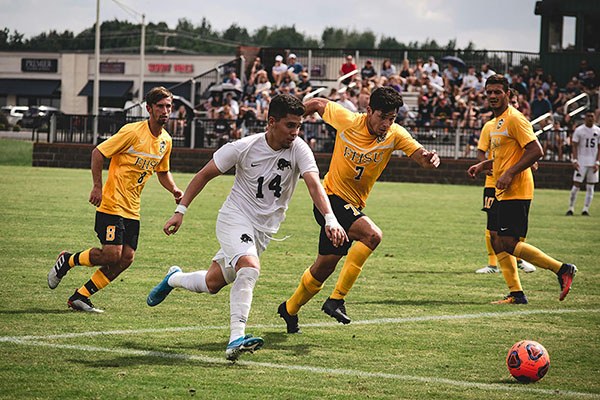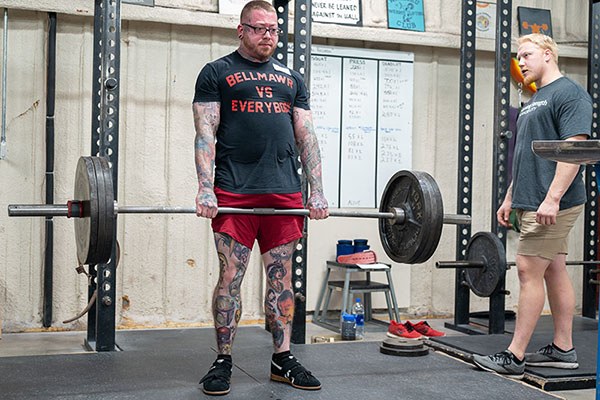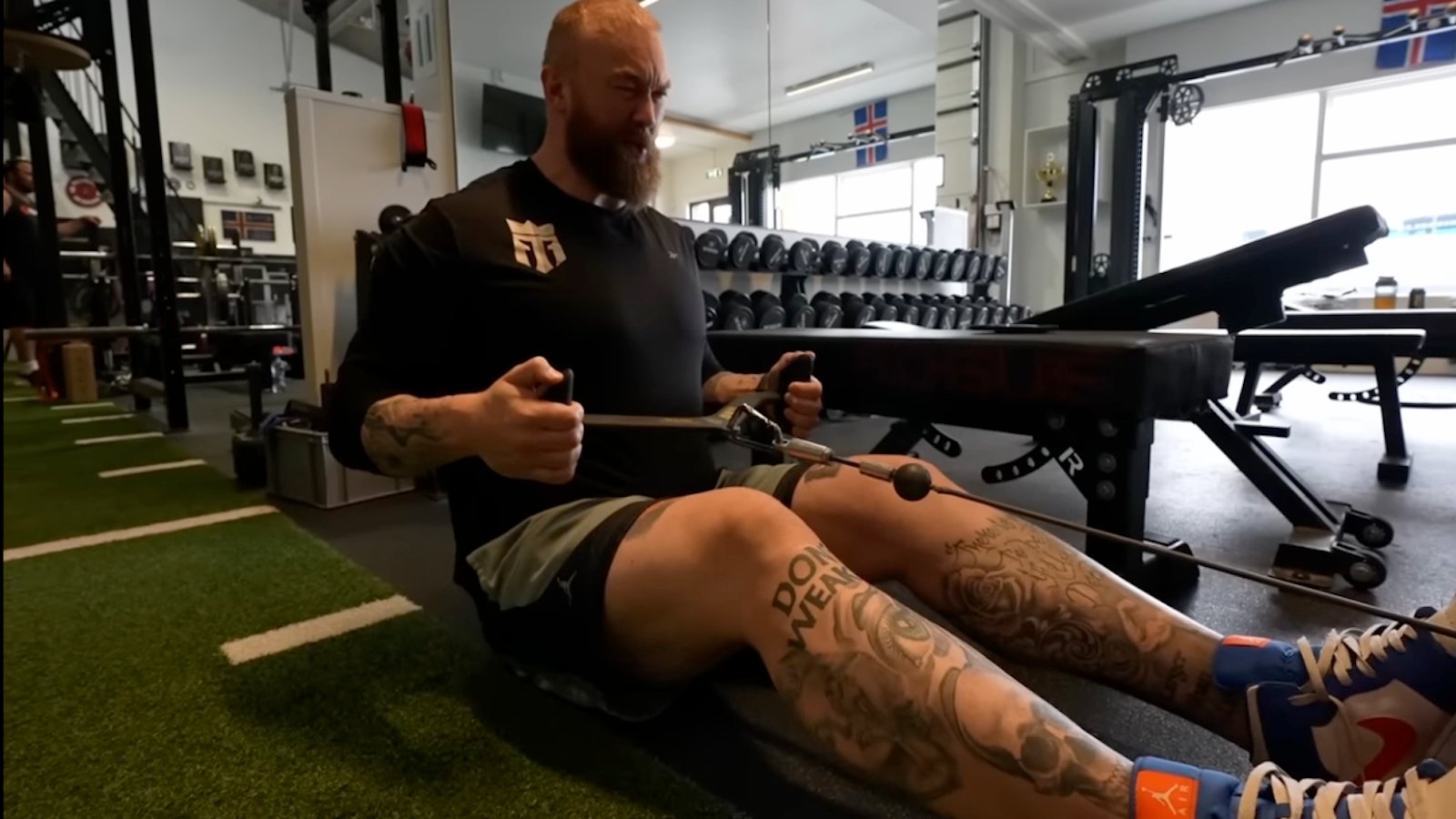In the last part of this series, we finish discussing why certain
popular exercises fail to yield the desired outcomes in athletic
performance. We then conclude the discussion about how to most
effectively and efficiently train for your sport by outlining how to
best organize an effective and efficient strength program.
What
about Speed, Agility, Quickness, Power, “Sport-Specific” and
“Functional” training? (Continued)
Adherents of these
“functional” and “sports-specific” exercise methods will
claim various benefits and aims, but the general theme is that these
exercises attempt to mimic activities of daily life and/or sports,
make them more challenging, and thus improve them. The problem is
that it doesn’t work the way they want it to. Aiming to improve
activities of daily living and athletic performance is an excellent
and noble idea. It’s for this reason that we prescribe lifting
heavy weights for anyone and everyone who has the need or desire for
physical improvement. Making training specific instead of general
never works, remember? So what is true functional training? Weighted
step-ups or squats and deadlifts?
“Soccer-specific
training” will, in a normal gym setting, look incredibly different
from “golf-specific training,” won’t it? One will have lots of
lunges, footwork drills, sprints, and jumping. The other will have
lots of “core stabilizing” work, rotational and anti-rotational
work, and probably a ton of hip and shoulder “mobility” work. I
hope, by now, you’re skeptical. In fact, the most effective
“soccer-specific training,” “golf-specific training,” and
everything in between involves heavy squatting, deadlifting,
pressing, bench pressing, and power cleaning.
By now, you already
know this. But this is a notion that completely ruins the business
model of sport-specific gyms that create different workout routines
for athletes of different sports. If nothing has to be especially
tailored yet progress is evident, the illusion of specificity is
broken. When the volleyball players do the same squats and presses as
the soccer players, and the golfers and everyone gets a heck of a lot
stronger and better at their sport by doing so, suddenly the veil of
complexity is shattered. Suddenly what matters is not “variety,”
“individuality,” “the programming,” or making training
“specific” to the sport, but instead, simple progress under the
bar. If you want to improve, your goal must be progress, and you must
learn to identify when a program that promotes progress is merely
hiding behind the distractions of variety, complexity, specificity,
and confusion.
Devoting time to this
nebulous realm of “training” is probably even more of a waste of
resources than conditioning. Speed/Agility/Quickness (“SAQ”),
“rate of force production,” “explosiveness,” or “power”
training are not so much ways for athletes to improve (past basic
levels at younger ages as they are naturally developing their
coordination and proprioception) as they are a way for the already
genetically-better ones to stand out and the worse-off ones to
struggle. In other words, it’s not training at all, but instead a
display of ability that is already there. Coaches know this even if
they don’t admit it to themselves. The good kids look good running
through the cones and ladders, and the ones who struggle look like
they’re struggling.
And therein lies the
more important issue. Power, explosiveness – call it what you want,
you know it when you see it – isn’t trained. It’s given at
birth by the DNA from your parents and ancestors. The explosive kids
are born that way. I’m as sorry about this as the next ex-aspiring
professional athlete, but it’s the truth. Coaches see this every
day.
Are the slower kids
really just lazier and not willing to put in the work (so often the
way we choose to lay the blame for their slowness)? Hardly. Are the
naturally quick kids just harder workers (so often the way we choose
to praise them for their speed)? Hardly. Sometimes this is true, but
realize that this is more of a confirmation bias than anything else.
The physically gifted kids naturally excel and have fun doing so, and
thus they often enjoy their sport much longer into life as their
athletic ability is repeatedly confirmed. And
sometimes the gifted kids don’t work as hard because they
don’t have to. Similarly, the “athletically modest” kids
certainly can become discouraged or disinterested when they realize
that they are less able to keep up with their peers – the process
of selection is at work, and unfortunately they haven’t been
selected.
Is “training” for
speed, power, explosiveness or the like going to hurt? No, probably
not. Do a bunch of ladder drills and box jumps if it makes you happy.
But do it after your heavy squats, deadlifts and presses –
the real training that really makes the difference. The ROI for the
former activities is so pathetically miniscule when compared to
spending the same amount of time properly strength training that it
shouldn’t even merit consideration. This is why we focus on lifting
heavy weights and why we don’t care so much about lifting light
weights quickly or for dozens of reps at a time. The “quickly”
part can’t be much improved, but the “heavy weights” part can.
So if the program’s main focus is trying to address the “quickly”
part, how much are you going to really improve with that program?
It’s especially easy
to identify this genetic endowment when working with children over a
long period of time. Any teacher or coach can identify the one or two
kids in the kindergarten game who are going to be the all-stars later
in life. They’re already faster, stronger and more intuitive with
their bodies. Sure enough, if they keep playing they’re the
physically gifted teenagers and beyond. There’s a reason you can
find old home videos of Messi, Ronaldinho, Maradona and some of the
other greatest soccer players in the world absolutely destroying
their peers in early childhood. Not only are they more skilled from
birth, but they’re more physically gifted from a very young age as
well. It was never taught, it was never trained – it was just
there.
So if you can’t very
well train (i.e. improve) the genetic capacity responsible for
explosiveness, you must be on the lookout for programs that claim
they can. Programs that tout “speed training,” “power,” “rate
of force production,” “agility/quickness,” etc. must be avoided
if you want your efforts to yield big results (unless of course these
programs involve a lot of heavy lifting, but they never do). Because
these will always, unfortunately, misunderstand and oversell what can
actually be achieved in explosiveness and agility in a gym setting.
Will
it work?
Now that you understand
which physical and physiological improvements are worth pursuing and
the best way to train to get results for these pursuits, and when
you’ve determined what specifically your athlete needs to improve,
you must be able to critically identify whether a program will
provide the outcome you’re looking for. We’ve already discussed
various ways in which a program may not work. When in doubt, ask
yourself: Does this program, gym, trainer, system, clinic, etc.
include the specific work required to promote the outcome I need? Does it prioritize this outcome, or is it a tertiary aspect of the
work done?
This, really, is the
simple part. If you’ve followed along so far, the conclusions are
clear. If you need to improve your skill, go work with the ball.
Identify which specific skill sets that need improvement, and go
practice a million times – rote repetition with the goal of
perfection. If you’re seeking external help in this area from a
qualified coach, make sure you’re only receiving skill coaching.
Avoid anything with “fitness,” “strength,” “power,” or
“cardio” in the program name. Do not dilute the effect of your
efforts. Remember, training and practice must be separate if
either is to noticeably improve.
If you need to improve
your conditioning, run or work harder in practice and/or pre-season.
Adequate intensity tends to be an issue for the under-conditioned
athlete. Don’t be lazy. Anyone can be under-conditioned if they
don’t actually play up to full speed.
Everything else
benefits from an increase in strength. Yes, even if you’re slow and
are trying to get faster. It bears repeating: to improve strength,
you must train for force production, regardless of your sport. Lift
heavy weights. This requires the right equipment, and it can benefit
from the right hands-on guidance.
What
Works and What Doesn’t
To get stronger, you
already know which exercises you need to do and why. What you must
now understand is that it is incumbent upon a good program to force
adaptation to happen. If you’re in high school, pay attention in
Biology. For those well past that point, all you need to do is
remember the simple process of Stress/Recovery/Adaptation and the
SAID (Specific Adaptation to Imposed Demand) principle. Lifting the
same weights over time will do nothing other than keep an athlete’s
strength levels exactly the same, because there is no further stress
requiring an adaptation. If stronger is the goal, the stress must
continually increase, and the stress stimulus must be force
production.
The SAID principle
illustrates that the stress must be specific to the adaptation we
want. If I want to get better at playing the guitar, I can practice
my scales at a higher BPM. To get stronger, I must give my physical
system the challenge of producing more force. Luckily, this is
incredibly simple: add 5 pounds to the bar every time you lift, and
you’ve given the body the stress it needs to force a specific
adaptation. This is referred to as progressive overload. In
other words, adding 5 more pounds provides adequate stress to tell
the body it better recover and then be ready for a bigger load next
time. It’s simple, and beautiful, and it works every time.
At this point, we
should be able to paint a pretty detailed picture of what a good
athletic performance program looks like. It must be specific to the
specific outcome we need. It should be a sport-specific skill-based
program, a sport-specific conditioning program, and a strength
program. That’s it. The different elements shouldn’t be mixed
together. They can be trained concurrently (in the same week), but
not together (mixed into the same workout). Let’s clearly lay out
the important aspects of a proper strength training program, which
should encompass the vast majority of an athlete’s off-field
training.
The athlete should
squat, deadlift, bench press, press, power clean and power snatch in
accordance with the four criteria we reviewed earlier. Older,
banged-up athletes may do well to omit the cleans and snatches. The
best proven sets x reps scheme is 3×5 for the squat, bench press, and
press, and 1×5 for the deadlift, while keeping cleans and snatches to
many sets of 2-3 reps. This allows heavy weight to be continually
used while allowing for continual progress.
All, or nearly all, of
the athlete’s time should be spent lifting weights. This should
take 60-90 minutes – not 20-30 minutes – each session. Ideally,
there should be three training sessions per week (this is the
stress). The athlete
should prioritize recovery
by eating plenty of protein and calories, resting adequately between
sets in the gym and days in between workouts, and sleeping a minimum
of eight hours a night. The athlete should add weight to every
exercise every time they train, 5 pounds for squats and deadlifts,
2-3 pounds for the upper body lifts is a nice simple plan, but it is
arbitrary. Do what you can, but go up every time for as long
as possible. This both demonstrates and forces a strength increase –
the adaptation.
Ideally, the lifts
should follow a model based on efficiency, safety, first principles,
and the four criteria laid out previously. This is where learning the
Starting Strength method or hiring a coach comes in handy. Even
without the ideal application, you can and will get strong if you
follow the above layout.
Too simple, right?
Simple works – simple, general, and basic. Starting Strength was
developed and is continually fine-tuned in the real world by
observing what works and what doesn’t work. It was not hypothesized
in a lab or classroom and then (*fingers crossed*) reality-tested
after the fact. We do not cling to the principles of the program
because of heavily-invested time and money from which we’re
desperate to profit. We believe in them because they have proven
themselves time and again, and because most of us have wasted so much
of our own time (and often others’ as well) doing countless things
that haven’t produced results. These are the principles that will
give you results. If you want results, you must seek a
results-oriented program. The program must continually build upon
itself and progress upwards. You cannot make progress with random
workouts under the guise of “variety,” “new challenges,” or
“muscle confusion.”
All that’s needed to
get stronger is a squat rack, a platform, a bench, a good barbell,
plates, and chalk. Anything else is superfluous and unhelpful. Here’s
a non-exhaustive summary of things to avoid if strength is the goal:
Anything that isn’t the layout above, any combination of resistance
training and sport skill (whether general or specific skills),
anything that is marketed as “Soccer-Specific Strength” (again,
replace “soccer” with your sport of choice), probably any place
calling itself a “Lab,” making the gym exercises look like the
movements done on the field, artificial turf, high-tech stuff,
anything that is tracking speed, kettlebells, dumbbells, “getting a
pump,” plyometrics, sets of 10, moving light things fast, and
anything that cannot be improved methodically for months and years.
Remember, strength is about force production. Lifting light
weights fast is about sub-maximal force display. We don’t
train to demonstrate what we already have – we train to improve
what we need to acquire.
The hardest part about
making a good decision is having the proper understanding of what
works and what doesn’t. After having read this, you should be
well-equipped to make good decisions moving forward. You should be
able to see an Instagram post, walk by a gym, or read an article and
very quickly determine whether or not strength improvement is a main
feature of what you’re witnessing. If it’s not, you must ask
yourself, “What exactly are they accomplishing?”
Practicing and
improving your specific sport’s skills will make you better at that
sport. But getting stronger will also make you better at that sport.
The same cannot be said for inferior exercise methods. There is no
substitute for skill practice, and there is no substitute for
strength training. If you haven’t been truly training for strength
this far into your athletic career (or life), realize that you now
have an incredible opportunity for growth. Make the most of your time
and effort and prioritize the things that matter most.



